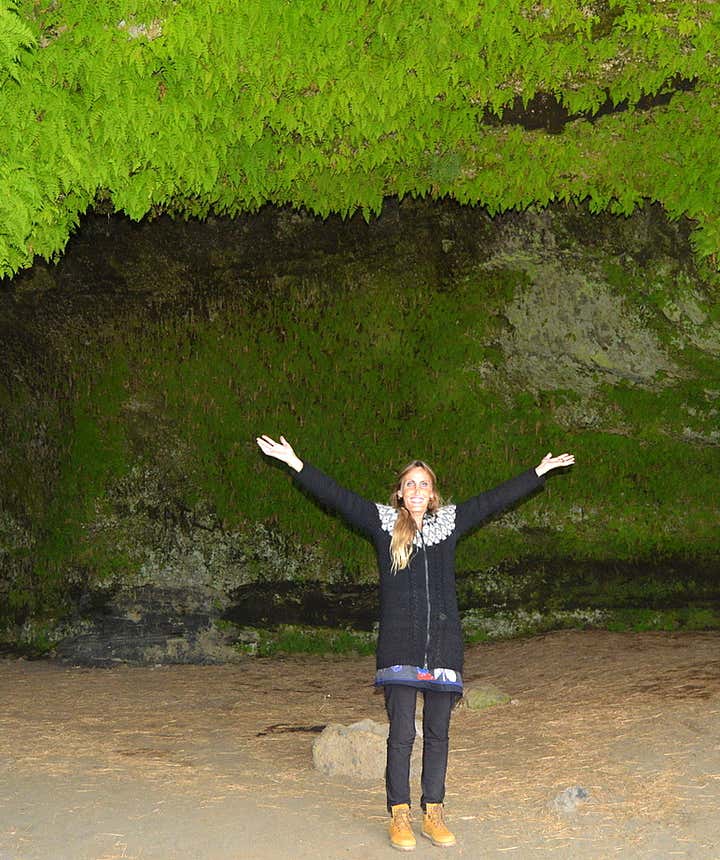
The historic Steinahellir Cave in South Iceland


There are supernatural stories connected to Steinahellir cave, some of which tell us about ghosts and the hidden people of Iceland.
One of them tells us about the wrath of the hidden people if we dare do one forbidden thing in the cave!
In this travel-blog I am going to tell you these stories and other interesting happenings in the Steinahellir cave, including a rebellion against the authorities.
Top photo: the entrance to Steinahellir cave
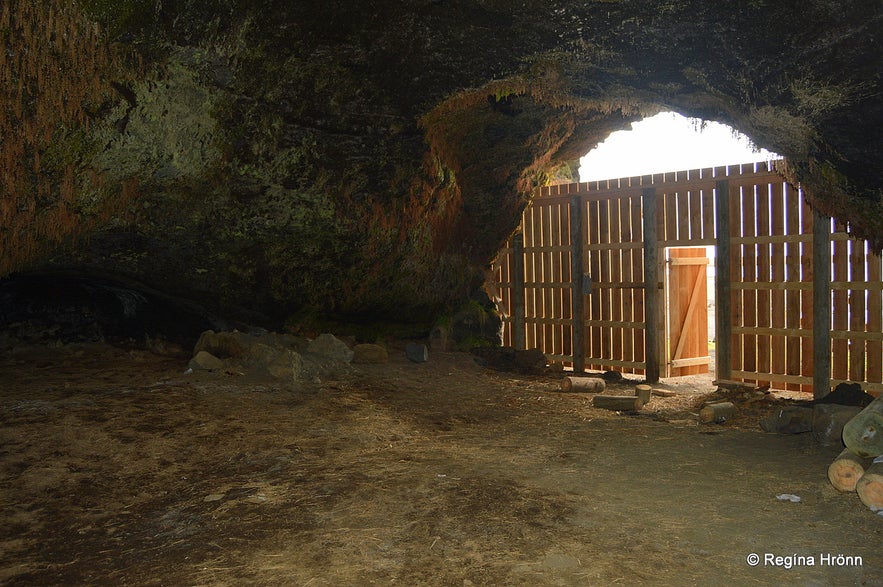 Inside Steinahellir cave
Inside Steinahellir cave
Steinahellir cave is believed to have been a natural cave that has been broadened and deepened.
Holtsós estuary almost reaches ring-road 1 by the cave and when the sea reached higher up it might have eroded a cave into the sandstone.
The cave is approx. 20 meters long, 9-10 meters wide, and 6-7 meters tall, but it gets lower when you walk further inside it (ref. Manngerðir hellar á Íslandi).
Close by is Steinar farm, which got its name from 2 stones where the old Steinakirkja church was built. They are called Kirkjusteinar - Church Stones.
Like so many other caves in Iceland, Steinahellir was used to keep sheep and it has also been used as a machinery shed. At one time ships were built by Steinahellir cave.
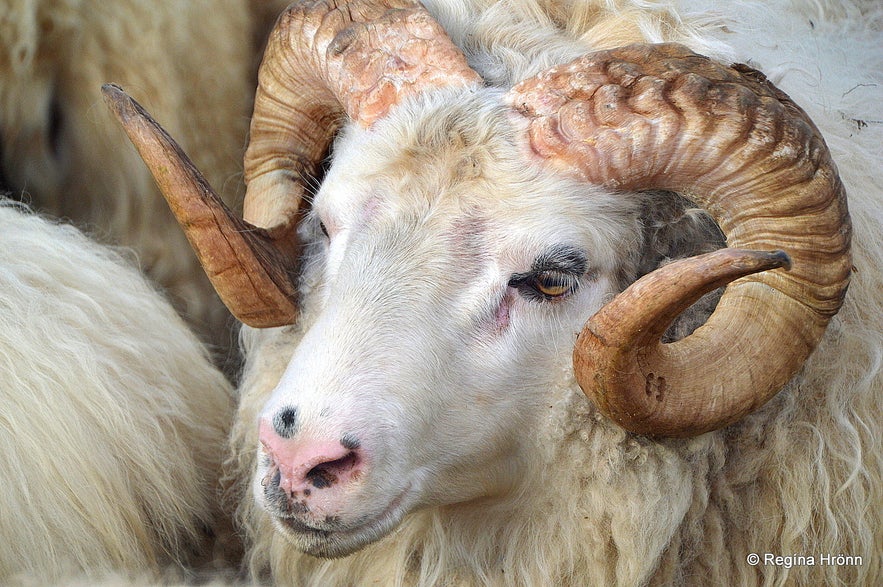 Icelandic sheep
Icelandic sheep
Then it changed its function and was the site of the parliamentary assembly for the locals Eyfellingar from 1818-1905.
Back then it was paneled with windows and a locked door, and there were benches and a parliament table inside. A parliament table from that time is preserved at Byggðasafnið Skógar which I recommend visiting.
Rebellion by Steinahellir cave
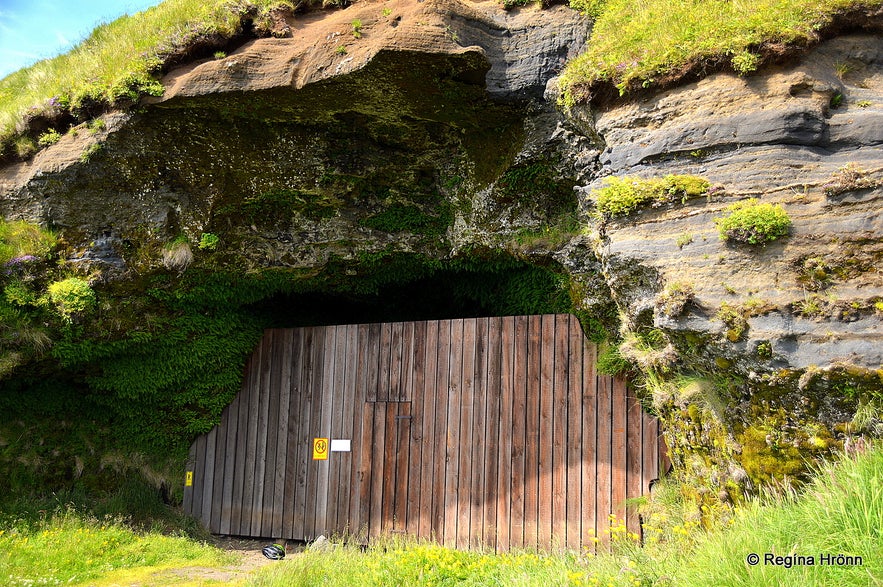
Steinahellir cave
Eyfellingar (the people living in this area) were feisty people. In 1858 Eyfellingar rebelled when the sheriff of Rangæingar and Prefect Trampe ordered the farmers to wash all their sheep to get rid of sheep scab.
Sheep scab had been discovered in some parts of Iceland but had not reached this area.
The farmers bluntly refused and didn't budge against strict orders from their authorities. So the sheriff and the prefect ordered them to meet up at the parliamentary assembly in Steinahellir cave on a set date and time.
 Sheep scab didn't reach this area of Iceland
Sheep scab didn't reach this area of Iceland
Around 80 of the farmers showed up and when the prefect and sheriff once again ordered them to wash their sheep the farmers were livid.
They surrounded the sheriff armed with whips, drove him to Lake Hellisvatn (Cave Lake) in front of Steinahellir cave, and threatened to bathe him instead.
The sheriff was petrified and couldn't escape from the angry farmers, and when Prefect Trampe understood that they had been overpowered he told the farmers that they could postpone bathing the sheep until next fall.
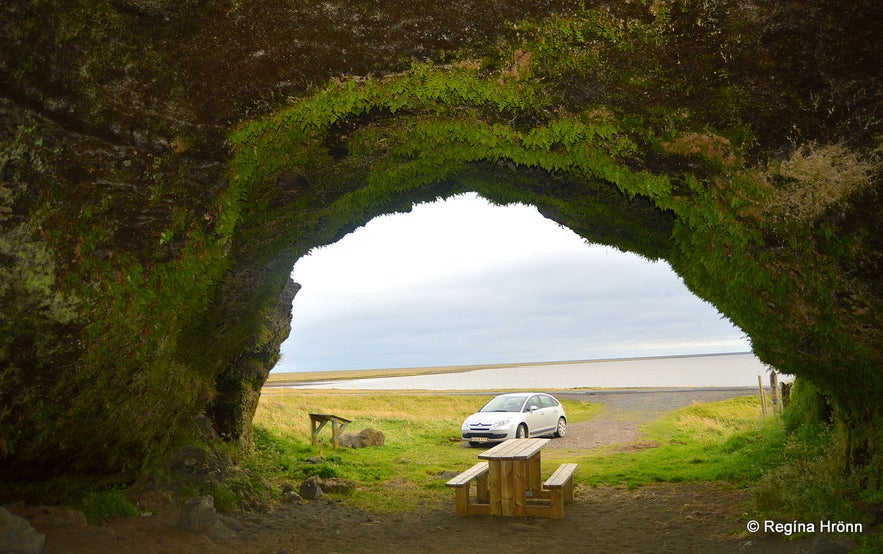
The Holtsós estuary almost reaches the main road
The farmers were adamant in not bathing their sheep at all and Trampe had to give in and told them that they only had to bathe their sheep if the sheep scab would reach this area - which it never did.
Floods and falling rocks
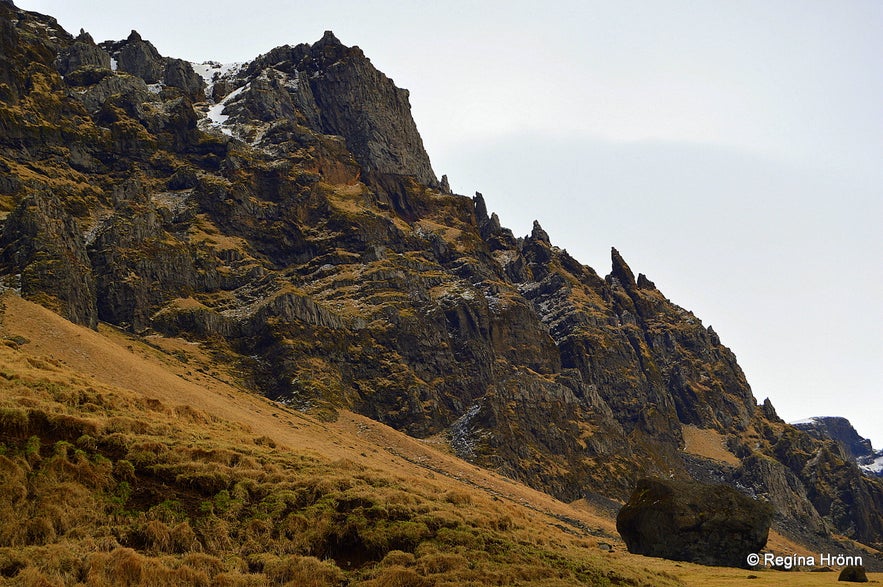 Boulders below Mt. Steinafjall
Boulders below Mt. Steinafjall
There is room for 60 sheep in Steinahellir cave. Nine sheep died in the cave in 1907 when rocks from the roof fell on them and killed them.
It had been foretold by the seer Jón Krukkur (16th century) that rocks would fall on the parliamentary members, but, fortunately, that didn't come true.
In 2011 rocks fell in the cave after heavy rain which affected the edge above the mouth of the cave. Fortunately, nobody was hurt.
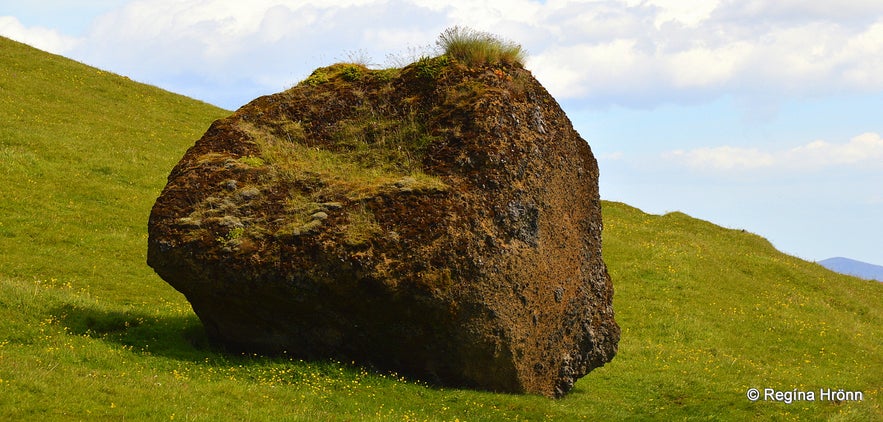 A boulder close to the Steinahellir cave
A boulder close to the Steinahellir cave
There have also been many rockslides and swellings of the Steinalækur creek in Mt. Steinafjall and in 1604 a huge boulder came rushing down the mountain.
It headed straight for the farms, damaged them, and then headed straight across the graveyard and into the Steinakirkja church.
It broke everything inside the church to pieces and stopped by the pulpit. It took 12 strong men with tools to remove the boulder (Steinar undir Eyjafjöllum).
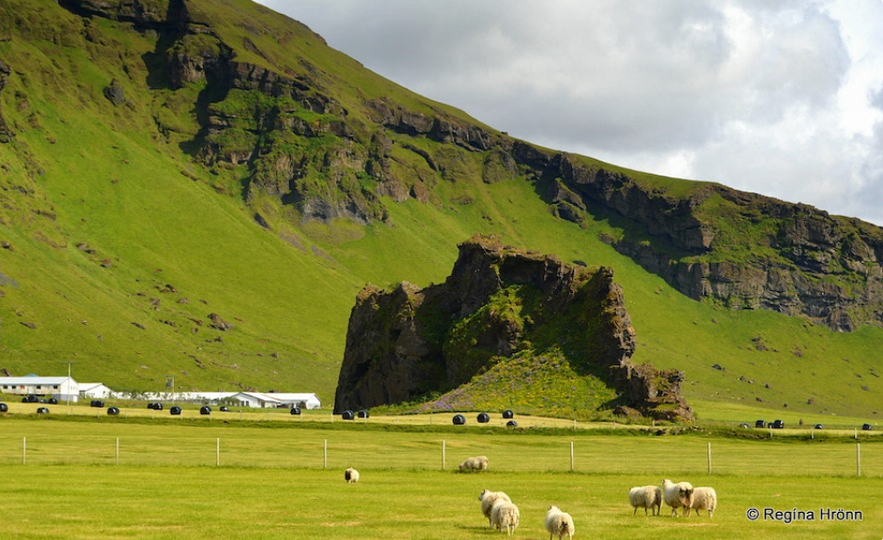
You will see many huge boulders beneath the Eyjafjöll mountains, that have come rushing down the mountains at some time.
Some of them have stories about the hidden people connected to them like Drangurinn in Drangshlíð and the Elves in South Iceland - Icelandic Folklore.
The 1888 flood in Steinalækur creek
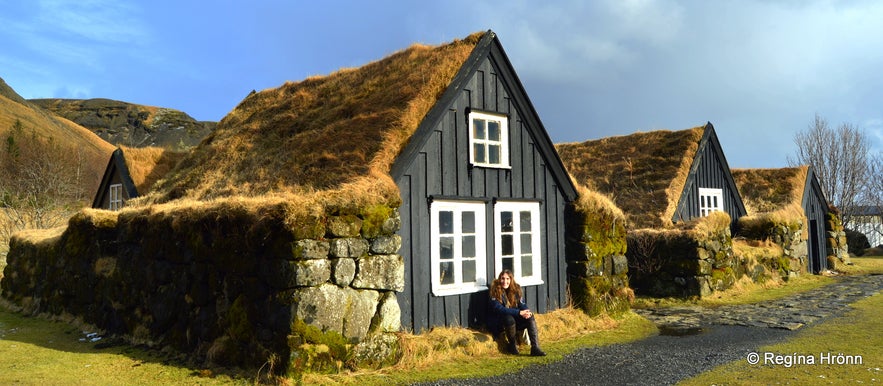 Back then people in Iceland lived in turf houses similar to the turf houses at the Skógasafn museum
Back then people in Iceland lived in turf houses similar to the turf houses at the Skógasafn museum
In 1888 a big flood hit the Steinar farms and greatly damaged them (there were 8 farms at Steinar at this time).
The small Steinalækur creek had turned into a water torrent and came rushing towards the farms.
The farmers had built a protective wall above the farms to protect them against falling rocks, but it didn't protect them against this massive swelling of the creek.
The farmers managed to let the lambs out of the lamb house, and the cows were taken to Steinahellir cave where they were safe from the flood.
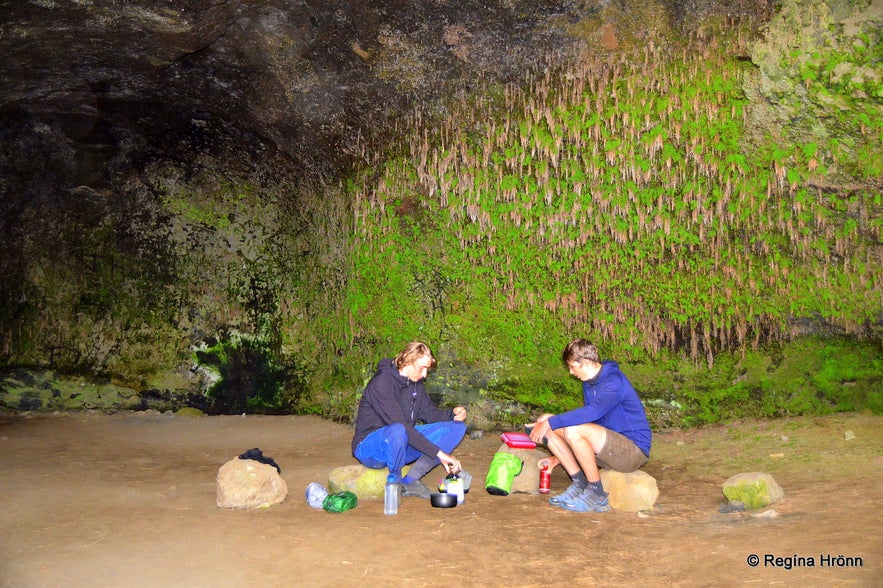 People inside Steinahellir cave
People inside Steinahellir cave
Several people guarded the cows at Steinahellir during the flood and they were milked in the cave in the evening.
The church bells at Steinakirkja church were rung for salvation during the flood.
The seer Jón Krukkur (Krukkspá) had predicted that Steinakirkja church protected the farm from falling rocks and rockslides, so the farmers loved their church even more for its protective role.
But a year later the Steinakirkja church was unchurched and torn down.
The 1926 flood in Steinalækur creek
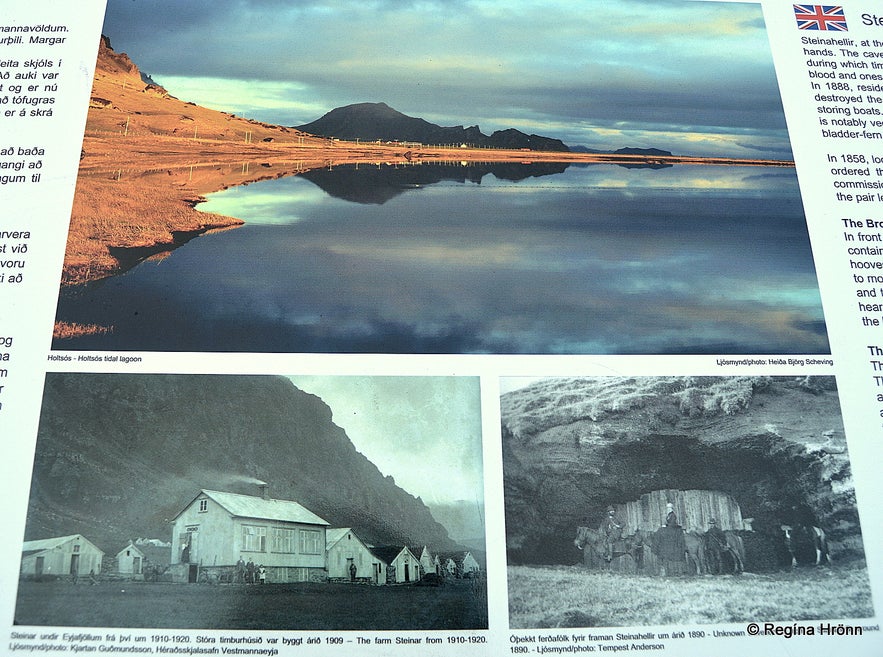
The old sign by Steinahellir cave shows us the farm Steinar
This is not the only misfortune to hit the Steinar farm. At Christmas time back in 1926 the small Steinalækur creek again swelled into an even more forceful river than in 1888.
There was a heavy downfall on the south coast, and the massive flood destroyed the farm.
The farmers and household at Steinar had a narrow escape but managed to save their livestock.
The poor people sat on the remaining roofs until early next morning. Two farms, 2 stalls, 5 stables, and 3 barns were swept away in this massive destructive flood.
This put an end to the old Steinar farms and new farms were built in a safer location on this land.
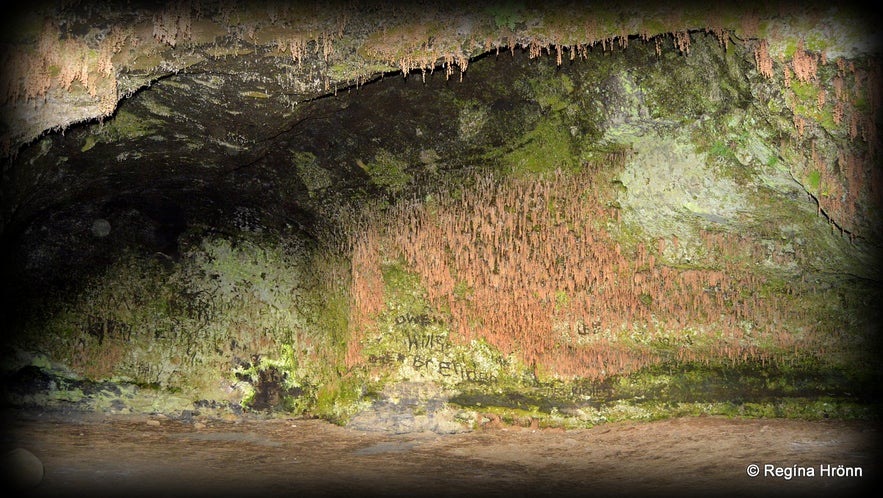 Inside Steinahellir cave
Inside Steinahellir cave
I read in the book Álög og bannhelgi by Árni Óla that a farmer who had to sell the Steinar farm for a small price put the curse on the farm that when the Steinakirkja church would be unchurched the creek would swell into a big river and destroy the Steinar farm.
Ghosts by Steinahellir cave
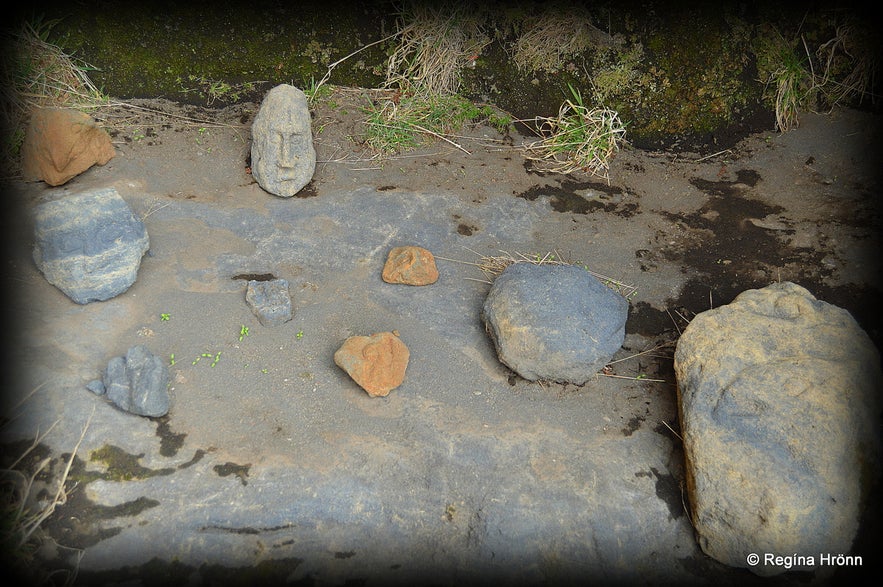
Inside Steinahellir cave in 2014
There is a story about ghosts in and around the cave, so don't camp overnight by the cave (camping is only allowed on campsites in Iceland).
I found the story and loosely translated it into English:
"Many years ago a ship with 14 sailors perished under the Eyjafjöll mountains (I have read that it was on Fjallasandur beach - RHR).
Three of them managed to crawl up on the keel and yelled for help as there were many men on the sand - the ship perished right before it reached the shore - but the surf was so forceful that it was impossible to help them.
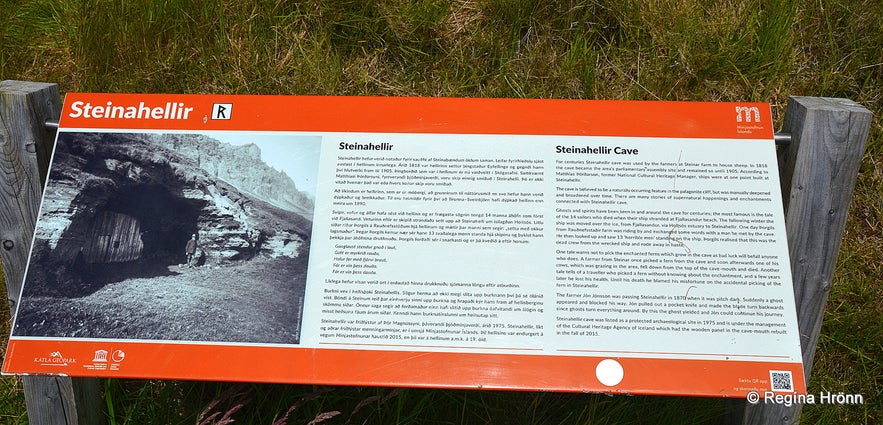 The information sign by Steinahellir cave tells us the story about the ghosts
The information sign by Steinahellir cave tells us the story about the ghosts
But as all of the men had drowned the ship capsized and sailed on its own ashore as if somebody was behind the steering wheel.
The ship was left on the beach until the next winter when it was pulled across the frozen Holtsós estuary to Steinahellir cave. People were afraid of this ship and nobody wanted to sail it.
When the ship was being pulled ashore, the shepherds from Steinar farm, who were guarding sheep under the mountains, got startled when they saw all the dead sailors walking behind the ship. And they looked very scary and ominous.
The ship was kept in a deep depression on one side of Steinahellir cave.
A little later a farmer from Rangárvellir, Þorgils by name, from the farm Rauðnefsstaðir, rode by Steinahellir in the winter darkness heading east, but the cave is by the thoroughfare.

Inside Steinahellir cave in 2014
After crossing a small creek west of the cave he met a man, whom he didn't recognize. The man said: "Sit by us, mate". He agreed, not suspecting anything as the ship could not be seen from the path. He rode with the man, even though his neighing horse protested.
When they reached the depression where the ship was kept, Þorkell saw 13 frightening-looking men standing around the ship.
He was startled when he recognized the dead ship crew from the shipwreck last fall, and realized that these men were ghosts, and hastily rode away from the cave and the ship.
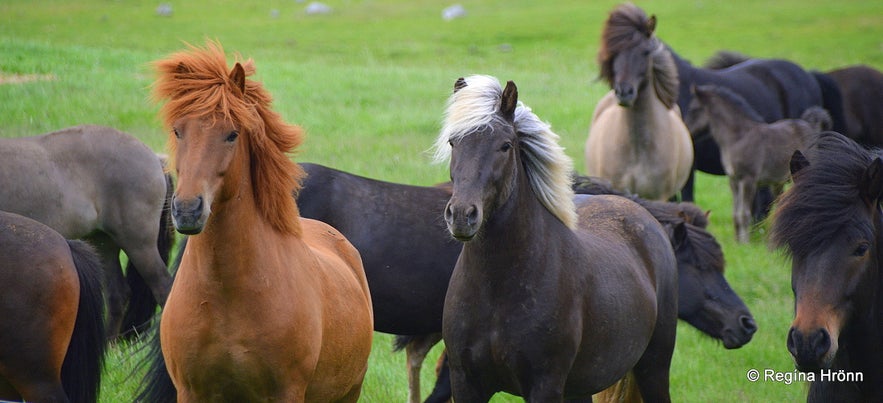 Icelandic horses
Icelandic horses
While escaping from the depression he heard the ghosts cite a poem that Þorkell memorised:
„Gangslaus stendur gnoð í laut.
Gott er myrkrið rauða.
Halur fer með fjörvi braut.
Fár er vin þess dauða,
Fár er vin þess dauða.“
He rode as fast as he could and reached the farm Steinar on that same night. Þorkell never again rode alone on this path, and even though it was during the middle of the day he always asked somebody to accompany him.
The ship was finally chopped down and used as firewood, but before it was chopped down people had frequently heard knocks and cracks from the ship, especially at night."
(Translated into English from Sagnakver Bj Bj - Draugaskipið - the Ghost ship)
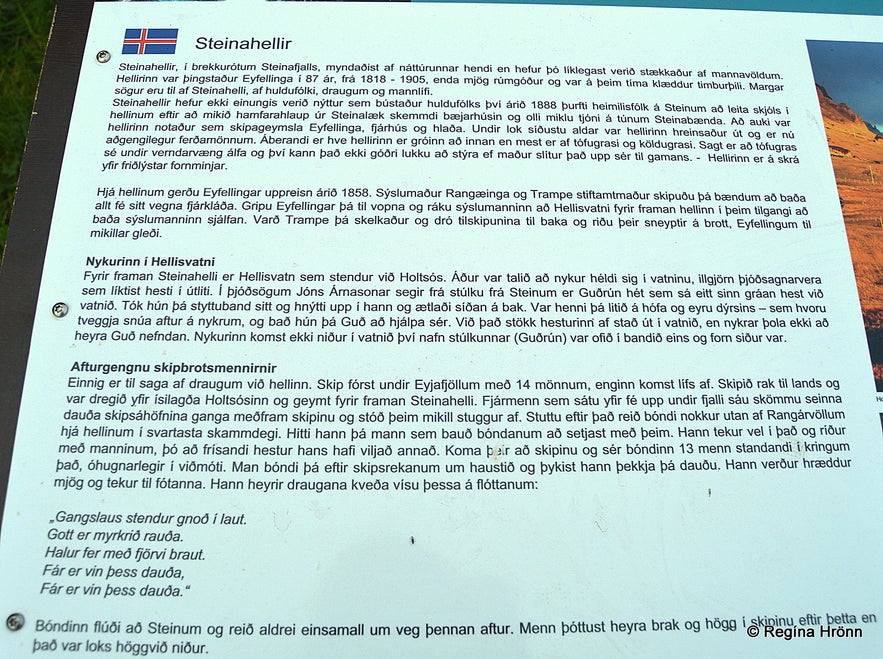 An information sign by Steinahellir cave
An information sign by Steinahellir cave
In 1870 the farmer Jón Jónsson was passing by the Steinahellir cave. It was pitch dark outside. All of a sudden a ghost stood in front of him on the path and blocked the way.
But Jón knew what to do; he pulled out his pocket knife and turned the blade backward.
This he did as he knew that ghosts turn everything around. The ghost made way for Jón who could then continue on his journey.
The enchanted fern in Steinahellir cave
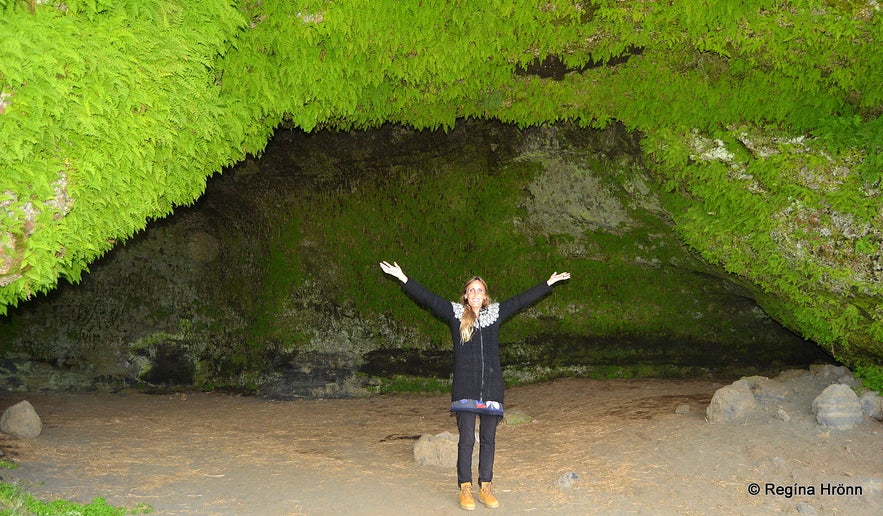
The enchanted green fern covers the ceiling of Steinahellir cave
On the ceiling of the cave, you will find brittle bladder ferns (tófugras). Icelandic folklore tells us that if you tamper with the brittle bladder fern misfortune will happen.
So this is an enchanted fern, most likely under the protection of the hidden people in Steinahellir cave.
Folklore tells us that one day a farmer from Steinar farm pulled some fern from the ceiling and shortly afterward one of his cows which was grazing near the top of the mouth of the brittle cave, fell to its death.
We have many stories in Icelandic folklore about the farmers' cows (especially their favourite cow) dying as a result of the farmers disobeying the hidden people of Iceland.
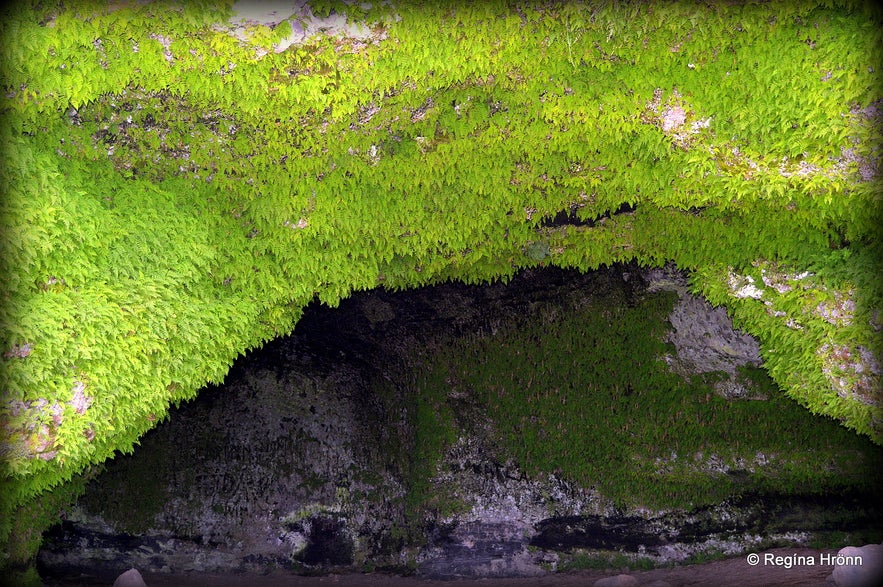
Enchanted fern in Steinahellir cave
There is another account of a traveller, who was unaware of the enchantment of the fern, so he picked it and lost his health.
He found out later that the fern was enchanted and blamed his ill health on the wrath of the elves/hidden people.
Folklore about Steinar and Steinahellir in Þjóðsögur Jóns Árnasonar
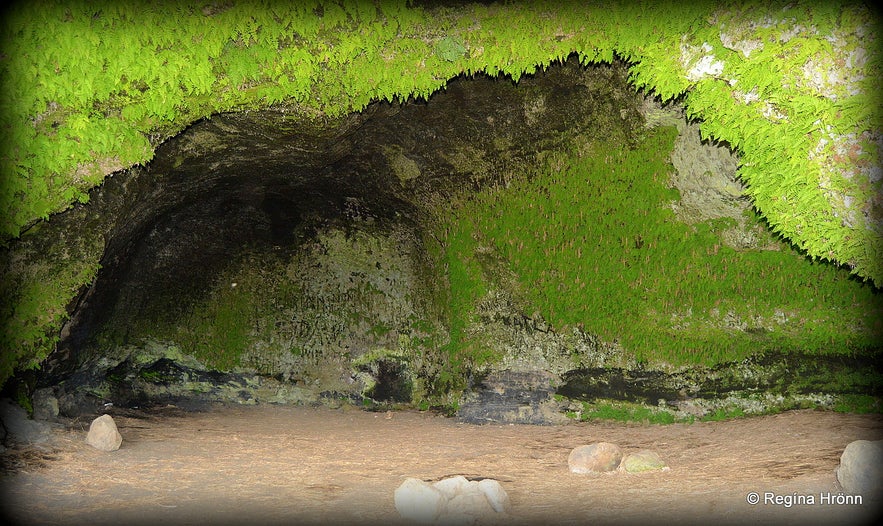
Inside Steinahellir cave
I found some folklore in Þjóðsögur Jóns Árnasonar - the Compilation of Folklore by Jón Árnason about Steinahellir cave (Volume III, pages 17-18):
Hidden people in Steinahellir cave:
"Steinahellir cave is now the site of the parliamentary assembly for the Eyjafjallasveit region since some years after the turn of the century, but earlier the parliament site was at Holt.
Since olden times the cave was used as a sheep barn, especially in bad weather. There aren't many tales about this cave, but all the same, it is considered to be the dwelling of the hidden people - and among other accounts, we have this tale:
Páll Jónsson skáldi (1779-1846) the minister in the Westman Islands, was traveling by the cave one evening with his daughter, Sólveig, who is now a midwife in the Westman Islands.
Sólveig saw crowds by the cave, and she had never seen as many people gathered together, but Minister Páll didn't see anything as he wasn't psychic.

Inside Steinahellir cave
And this folklore also tells us:
The first section of the cave is covered with brittle bladder fern. It is forbidden to tear it down or else misfortune will happen.
Once the district administrative officer, Skúli at Grund (1831-1909), the son of the minister Þorvarður, now at Prestsbakki at Síða, came riding east of the estuary.
It was moonlight and a crust of snow so it was an easy ride.
 An Icelandic horse
An Icelandic horse
As he came towards the rock in front of the cave door the horse stopped abruptly and refused to move.
As Skúli tried to force the horse to carry on it stood on its hind legs and snorted and made a scene (so to speak).
Skúli was stubborn and zealous and didn't want to give in to the horse, but in vain.
So he got off the horse and examined the area in all directions but didn't see anything. He then turned east and rode above the cave."

Somebody has carved their names on the walls of the protected cave, do not add any more names
The noted Þórður Tómasson tells us about Jón Jónsson (mid-19th century), who was the farmer at Klambrir undir Eyjafjöllum (beneath the Eyjafjöll mountains).
Jón Jónsson was psychic and once dined with the hidden people in (or inside the rock) at Steinahellir.
The hidden people offered him the hip of cured sheep (ram) (hangna sauðarmjöðm) and he learned the following grace from them:
"Matur í munn,/ kross á brjóst,/ heilagur andi í hjarta" - "Food in the mouth/cross on the chest/the Holy Spirit in the heart".
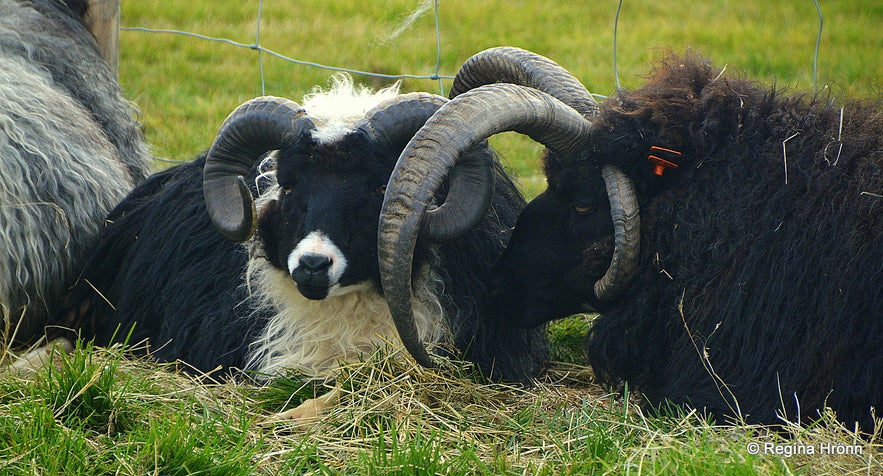 Icelandic rams
Icelandic rams
Steinahellir is also mentioned in volume III, page 44, where it is mentioned that the ships were by Steinahellir cave, as so often was the case.
At Steinar farm in the vicinity of the cave, a woman called Margrét Rafnkelsdóttir (1747-1836) often saw and heard the hidden people.
The hidden people fetched water in the well-house and she always kept it open for them. She could also hear them in the kitchen, the folklore tells us, and the pleasant smell of smoked lamb would reach her room.

The entrance to Steinahellir cave in 2014
And this is written in volume IV page 43:
"The cave is high at the front, but as you go further inside it lowers a little until it reaches the floor. There is a hole on its east and west sides.
The story goes, that the hole on the east side had reached very far, and once a calf had entered the east hole, and the people living on the westernmost part of the Steinar farm close by had heard the calf mooing beneath the floor in the pantry.
The other hole reached the pantry at the easternmost farm at Varmahlíð, which is quite far from the cave."
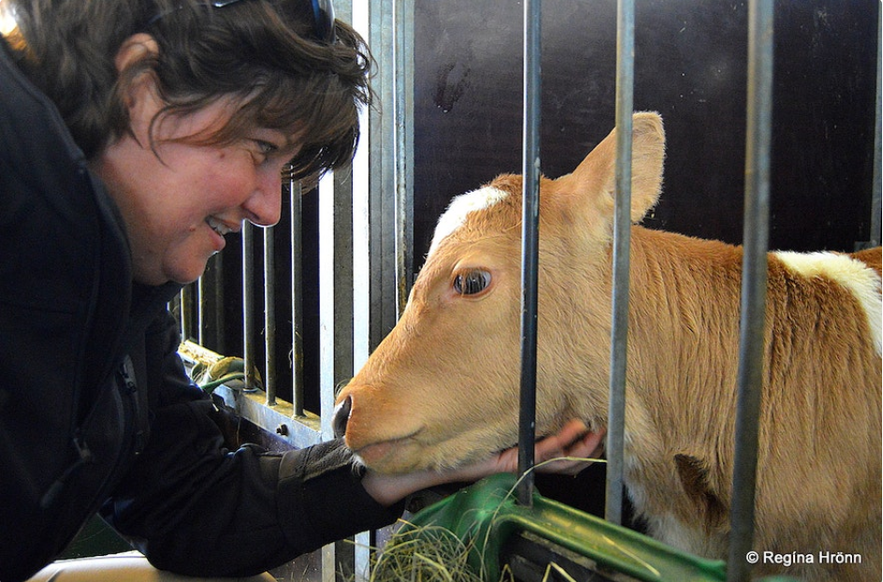
The story goes that a buried treasure is in the ridge west of the cave, because "mundarlogi" has been seen there.
This mundarlogi/fjárlogi is a special phenomenon where light hovers over buried treasures.
And once a large boulder had come rushing down the hill and stopped by the entrance to Steinahellir cave.
On top of it, a tussock grew and it was believed that inside it was a hidden treasure as light was seen hovering above it as well (vafurlogi).
The tussock was not to be touched or misfortune would happen.
 Fern in Steinahellir cave
Fern in Steinahellir cave
People obeyed this as misfortunes have been known to happen in Iceland if enchanted spots are disrupted, as I mentioned earlier.
But two zestful boys from the farm Steinar wanted to seek the treasure and disobeyed the orders. As they were burying in the tussock they saw what looked like the light from fire above the hill east of the cave.
It reached the sky with massive smoke. The boys thought that the Steinar farms might be on fire, so they stopped digging and rushed to the farm to help out, but as they came closer the smoke and the light from the fire disappeared.
The boys realizing that this was a warning, didn't touch the tussock from then on.
We have many such stories, and they are always a warning from the other world.
 Steinahellir cave
Steinahellir cave
The same happened by Skógafoss waterfall when they were trying to reach the treasure behind the waterfall as I told you about in my travel-blog: The Spectacular Skógafoss Waterfall in South-Iceland and the Legend of the Treasure Chest.
Road construction workers later blew up this rock when the road was being surveyed.
There is one mention in Þjóðsögur Jóns Árnasonar about a kelpie in Hellisvatn - Cave Lake. There are many stories about kelpies in Icelandic folklore one of which I have told you in Kerið crater and Nykurinn - the Water-kelpie in South Iceland.
Some of my photos are from my visit to the cave in 2014 when the cave was open. But since 2015 a wooden panel has closed the mouth of the cave.
 This yellow sign by Steinahellir tells us that it is a protected archaeological site
This yellow sign by Steinahellir tells us that it is a protected archaeological site
In 2020 I saw that signs had been added to the wooden panel.
The yellow sign, that I have shown you in many of my travel-blogs, has been fastened to the panel. On it is written "friðlýstar fornleifar" - a protected archaeological site.
See also: Ancient Ruins and Burial Mounds I have visited on my Travels in Iceland.
The cave has been protected since 1975 and is under the management of Minjastofnun Íslands - the Cultural Heritage Agency of Iceland.
All Icelanders know what this sign means, but most of our foreign visitors don't realize that it is a preserved historical cave.
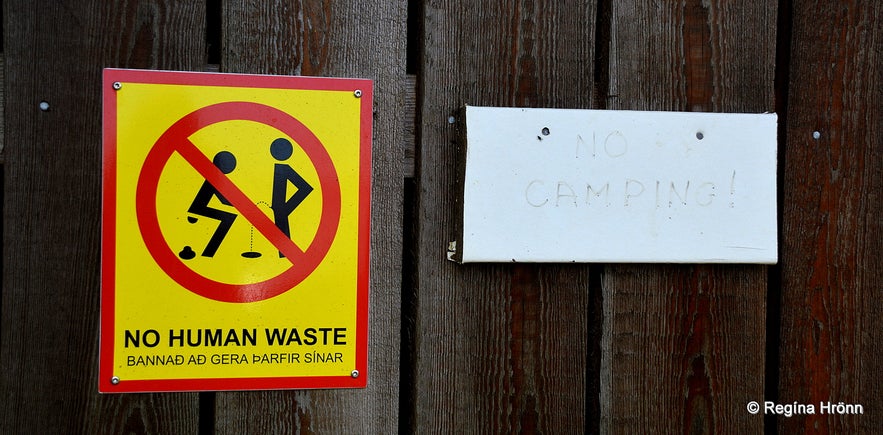
Signs by Steinahellir cave
On one occasion, when I entered the door of the cave two young guys on bikes were inside the cave.
They were happily lighting their camping gas stove, unaware that they were inside a preserved cave with a curse on it (the wrath of the hidden people if you mess with the enchanted fern).
They were so happy to have found a shelter, that I didn't want to spoil the moment for them and tell them that this was a preserved cave. So I just took some photos and left.
 This popular fence is close to Steinahellir cave - the Bra Fence
This popular fence is close to Steinahellir cave - the Bra Fence
So, when you visit Steinahellir cave be aware that it is an enchanted preserved cave with a lot of history, so let's tread lightly and only take photos and leave nothing behind but our footsteps :)
You know that you are close to the cave when you see the bra fence in my photo above. Hanging your bra there has become very popular for some reason.
Have a lovely time in Iceland :)
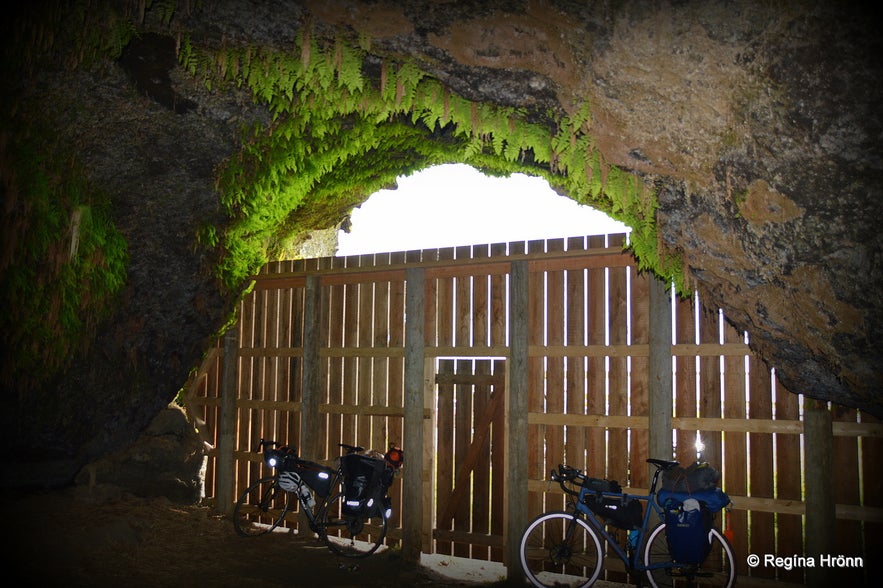 Inside Steinahellir cave
Inside Steinahellir cave
Ref. and further reading (in Icelandic):
Minjastofnun: Steinahellir undir Eyjafjöllum
Heima er bezt 1951 - Hræðileg jólanótt
Snerpa - Sagnakver Bj. Bj. - Draugaskipið
Vísir 1966- Steinar undir Eyjafjöllum
Álög og bannhelgi - Árni Óla - Álög á Steinum pages 198-199
Manngerðir hellar á Íslandi pages 251-255
Eyfellskar sagnir by Þórður Tómasson, published in 1949 Volume II, pages 114-115 and 162-169
Setið við Sagnabrunn - Þórður Tómasson í Skógum pages 16 and 27
Otros blogs interesantes
Chasing Waterfalls in Iceland
Iceland is spectacular in so many ways and Icelandic nature is quite unique with its vast landscape, volcanic activity, geothermal areas, glacier lagoons and sceneries, black sand beaches and spectLeer másSænautasel Turf House in the Highland of Iceland
In my search for turf houses around Iceland, I visited Sænautasel, which is a rebuilt turf house on Jökuldalsheiði heath in the highland of Iceland. It is, in my opinion, an extremely cute turf hoLeer másThe Dynamic Plant Lupine
People have been asking me where to find lupines in Iceland. If you like them you should be able to find them easily in Iceland in summer. They are in bloom and visible almost wherever you drive aroLeer más

Descarga la mayor plataforma de viajes a Islandia en tu móvil para gestionar tu viaje al completo desde un solo sitio
Escanea este código QR con la cámara de tu móvil y pulsa en el enlace que aparece para añadir la mayor plataforma de viajes a Islandia a tu bolsillo. Indica tu número de teléfono o dirección de correo electrónico para recibir un SMS o correo electrónico con el enlace de descarga.















